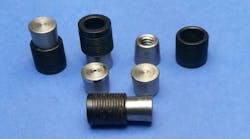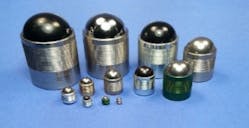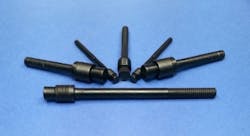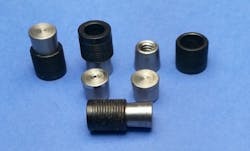Expansion plugs provide a permanent, leak-tight sealing of fluid passages in hydraulic manifolds, castings, and other components without having to use O-rings, threads, or sealants. Several methods exist for installing the plug and expanding its circumference to establish as tight seal against the inside diameter of the drilled hole.
Ball style—Originally developed as an alternative to threaded plugs, ball style expansion plugs simplified the machining of the end of the drilled hole. The plug’s design uses a simple +0.12/−0.00 mm) counterbore hole to ensure a permanent, leak-proof seal, at pressures to 6,250 psi (350 bar) at a 3:1 safety factor.
Installation for low-volume applications is accomplished using a set tool and hammer or an arbor press, tapping or pressing the ball down into the sleeve until reaching its final desired position. In higher-volume applications, operators air hammers or automate equipment is used to drive the ball into the sleeve, thus speeding up the installation.
Rivet style—developed about 30 years ago, rivet-style plugs again simplified machining of the end of the drilled hole, requiring only a straight bore (+.12 mm/−0). The design often requires a smaller plug being than with the ball style. Rivet-style plugs introduced a hydro-pneumatic installation tool to secure the proper installation of the expander, virtually eliminating any potential installation error by relying on the tool to break the plug vs. an operator pressing the ball to the proper depth.
Operators insert the plug into the hydro-pneumatic tool, press the plug against the hole to be sealed, and depress the tool’s trigger. With the tool maintaining flush contact with the surface of work piece, the internal components of the tool grab a mandrel while holding the body of the plug just below the surface of the workpiece. The tool draws the pin into the body until the necked down area of the plug reaches its desired break point. When this occurs, the pin fully engages the body, causing radial expansion sealing the hole at 7,250 psi (500 bar) at a 3:1 safety factor. A quick, simple, and cost-effective permanent seal, the rivet style plug was an improvement to expansion plugs for many applications.
A Newer Option
These two options come in a variety of material choices, sizes, pressure ratings, and installation tools. The EIS pull plug was introduced in 2013 and automatically threads the plug onto the installation tool’s mandrel until ready to insert into the hole for sealing. Unlike the ball-style plus, the EIS Pull Plug does not require a counterbore, nor does it rely on the reaching a break force, as with the rivet-style plug
After placing the expansion plug into the straight bore hole (while the nose of the tool keeps the plug body slightly below flush to the surface of the work piece), the operator then depresses the tool’s trigger. This actuates the tool to pull the pin into the plug body at a predetermined stroke. The EIS Pull Plug also eliminates the waste and associated cost of breaking a rivet pin with every plug installed.
Another benefit is greater versatility because the expansion plug can be installed at a depth below the surface of the workpiece. Having the mandrel built onto the tooling allows installing at the plug any depth within the manifold by simply using a longer (interchangeable) mandrel and sleeve on the tool. In addition, a flow restrictor by can be created by drilling a hole (orifice) through the pin.
The EIS Pull Plug comes in carbon and stainless steels, aluminum, and titanium. Standard sizes are sizes (5 mm to 20 mm) for both low- and high-pressure versions.
Brian Krieger is with Engineered Inserts & Systems Inc., Watertown, Conn. For more information call (203) 301-3334 or visit www.eisinserts.com.





